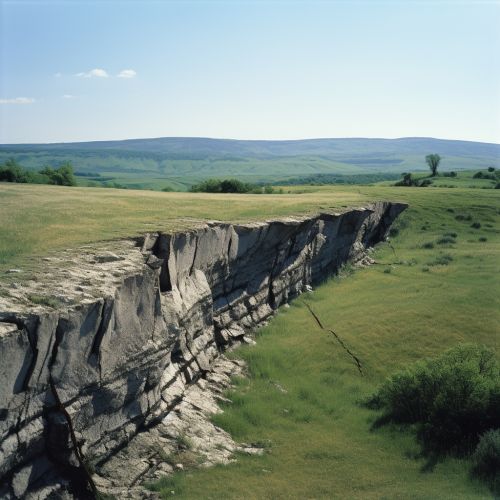Normal fault
Introduction
A normal fault is a type of fault, or fracture in the Earth's crust, where the rock mass located above the fault plane, known as the hanging wall, moves down relative to the rock mass below the fault plane, known as the footwall. This movement is caused by tensional forces and results in extension. Normal faults are significant geological features because they can lead to the formation of rift valleys and play a crucial role in the development of plate tectonics.


Formation
Normal faults are typically the result of tensional forces within the Earth's crust. These forces pull the rocks apart, causing them to fracture and creating a fault. The tensional forces are usually the result of lithospheric plate movement or the weight of overlying rock strata. When these forces exceed the strength of the rock, a fracture occurs, and one block of rock moves downward relative to the other.
Characteristics
Normal faults can range in size from small fractures that are only a few meters long to large faults that span hundreds of kilometers. The angle of the fault plane with respect to the surface of the Earth can also vary. In most cases, the fault plane of a normal fault is inclined at an angle less than 45 degrees.
Types of Normal Faults
There are two main types of normal faults: high-angle and low-angle. High-angle normal faults are those where the fault plane is inclined at an angle greater than 45 degrees. These are the most common type of normal fault. Low-angle normal faults, also known as detachment faults, have a fault plane that is inclined at an angle less than 45 degrees.
Effects of Normal Faulting
Normal faulting can have significant effects on the landscape. The downward movement of the hanging wall can lead to the formation of a rift valley. This is a valley that is bounded by normal faults on either side. Normal faults can also lead to the formation of mountain ranges and basins.
Normal Faults and Plate Tectonics
Normal faults play a crucial role in the development of plate tectonics. They are commonly found at divergent plate boundaries, where two plates are moving away from each other. The tensional forces at these boundaries lead to the formation of normal faults, which allow the lithosphere to extend and create space for new crust to form.
